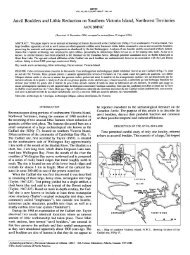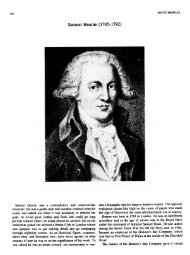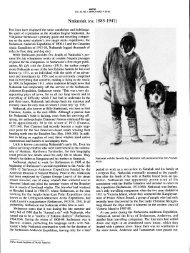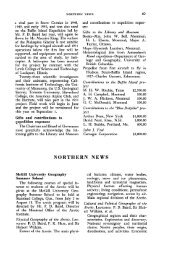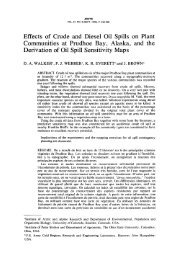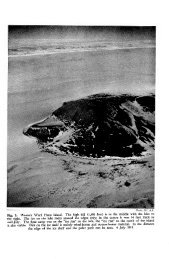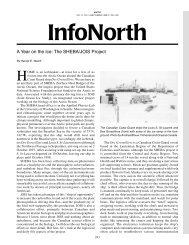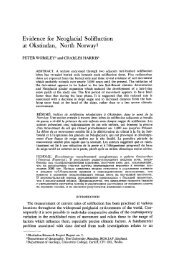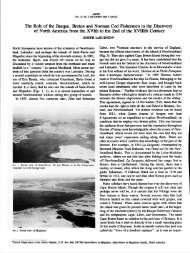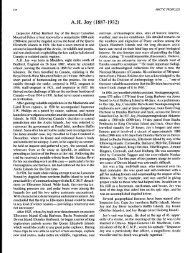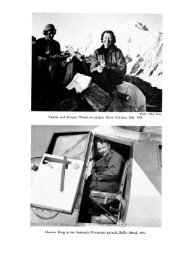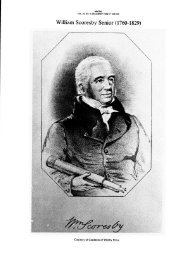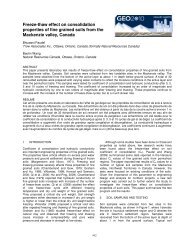To Make These Tribes Understand - AINA Publications Server
To Make These Tribes Understand - AINA Publications Server
To Make These Tribes Understand - AINA Publications Server
You also want an ePaper? Increase the reach of your titles
YUMPU automatically turns print PDFs into web optimized ePapers that Google loves.
224 • K.S. COATES and W.R. MORRISON<br />
FIG. 3. Alikomiak, summer 1922. National Archives of Canada, PA-102577.<br />
strikes or Indian protests. Later, they waved the flag for the<br />
first time in the Yukon during the gold rush of 1897–98, and<br />
in the Arctic between 1903 and 1925. It was not until World<br />
War I that their duties were extended to matters such as<br />
national security—investigating putative German spies, and<br />
the like. When Doak and Binder were killed, the police were<br />
the main (indeed, the only) representatives of Canada in the<br />
Arctic, and the attack on them was an attack on Canadian<br />
sovereignty in the region—sovereignty which, because it was<br />
based on some questionable foundations, had to be all the<br />
more carefully defended. It was for these reasons that the trial<br />
of Alikomiak and Tatamigana took on some of the characteristics<br />
of a “show trial.”<br />
Thus the trials that took place at Herschel Island in July<br />
1923 were carefully planned, both for their political impact<br />
and for logistical reasons. The island was chosen because it<br />
was easily accessible and was the only community along the<br />
Arctic coast that had buildings of any considerable size—<br />
these were left over from the whaling days. Judge Lucien<br />
Dubuc of Edmonton, who was also a stipendiary magistrate<br />
of the Northwest Territories, was sent north as judge (Fig. 5).<br />
A student of the territorial judiciary later described Dubuc as<br />
follows:<br />
FIG. 4. Eskimo prisoners at Herschel Island. Alikomiak is fifth from the left and<br />
Tatamigana is barely visible third from the left. National Archives of Canada,<br />
RCMP Collection, Neg. No. 881.<br />
[He was] a compassionate individual who was suited to<br />
the task of introducing the Inuit of the Mackenzie Delta to<br />
only the broad principles of the “white man’s justice.”<br />
There is no evidence, however, that [he] delved extensively<br />
into Inuit customs or their mode of living. Rather he<br />
introduced the formal trappings of the white man’s justice<br />
leaving it to later Magistrates … to try to apply, with<br />
sensitivity, the substance of the white man’s law to the<br />
Inuit. (Price, 1986:317)<br />
Dubuc was accompanied by T.L. Cory, solicitor for the<br />
Northwest Territories Office of the Department of the Interior,<br />
who was appointed counsel for the accused, and I.B.<br />
Howatt, counsel acting for the Crown. The jury was selected<br />
from white residents of the communities along the Mackenzie<br />
River, who travelled with the court party. Preparations were<br />
made for the likelihood of a conviction. The travel season in<br />
that region was short, and it was realized that if the verdict<br />
were guilty, it would be impossible to hang anyone for a year,<br />
until travel made it possible for the hangman to come to<br />
Herschel Island in the summer of 1924. <strong>To</strong> avoid such delay,<br />
which would have weakened the whole point of the proceedings,<br />
the hangman, Special Constable Gill, accompanied the<br />
party, and because of the shortage of suitable timber on<br />
Herschel Island, a portable gallows was taken along as well.<br />
Private correspondence from government officials and<br />
others before the trial began made it appear that example and<br />
deterrence were the main goals. Cortland Starnes, Assistant<br />
Commissioner of the RCMP, commented that the previous<br />
policy of leniency towards Inuit who killed outsiders had not<br />
worked, and that there was a danger that these people would<br />
conclude “that crime is a thing to be rewarded by the White<br />
man.” He recommended that steps be taken to “impress upon<br />
the Eskimo that such disregard for human life will not be<br />
tolerated and those found guilty of committing murder will be<br />
adequately punished” (Starnes, 1922).<br />
Perhaps the most remarkable comment made before the<br />
trial came from the lawyer appointed to defend the accused.<br />
T.L. Cory, as solicitor for the Northwest Territories Branch,<br />
was a government employee. His employer, the Department<br />
of the Interior, was the arm of government most concerned<br />
with the establishment of peace, order, and good government<br />
in northern Canada. Moreover, W.W. Cory, the Deputy



